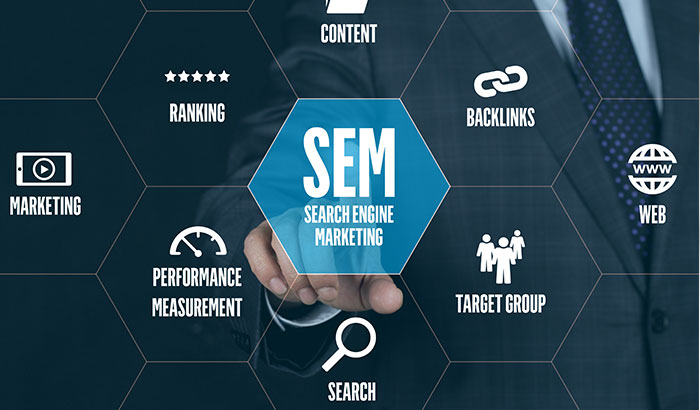Search Engine Marketing, or SEM Marketing, is a form of digital marketing that involves using paid advertising to increase visibility and drive traffic to a website. This can include paid search ads, display ads, and other paid advertising on search engines like Google and Bing.
The importance of SEM in modern digital marketing cannot be overstated. As more and more consumers turn to search engines to find products, services, and information, the ability to reach them through paid advertising has become crucial for businesses of all sizes.
SEM allows businesses to target specific audiences and keywords and track and analyze their campaigns’ performance, making it a highly effective and efficient way to drive online sales and conversions.
Additionally, SEM can provide immediate results and help to build brand awareness, making it a valuable tool for businesses looking to establish or increase their online presence.
Learning to Understand SEM
Search Engine Marketing works by placing paid ads on search engine results pages (SERPs) and other websites. These ads are typically triggered by specific keywords or phrases relevant to the advertiser’s business or products.
There are several different types of ads in SEM marketing, each with unique characteristics and advantages.
Pay-per-click (PPC) ads are one of the most common forms of SEM. PPC ads are typically displayed at the top or bottom of SERPs and are triggered by specific keywords or phrases relevant to the advertiser’s business or products.
Advertisers only pay when someone clicks on their ad, hence the name pay-per-click. PPC can be a very effective way to drive targeted traffic to a website and can be particularly useful for businesses looking to increase sales or leads.
Display ads are another common form of SEM. These ads are typically image-based and are displayed on other websites, typically in the form of banners or different media types.
Display ads are usually less targeted than PPC ads, but they can be a valuable way to build brand awareness and increase website traffic. They can also be helpful for remarketing campaigns – showing ads to people who have previously visited a website.
Search ads are similar to PPC ads but appear at the top or bottom of SERPs, next to the organic results. They allow businesses to reach their target audience when they are searching for specific keywords or phrases. They are highly targeted and are considered to be more effective than display ads.
Dynamic ads, also known as retargeting ads, are a form of SEM that allow businesses to show ads to people who have previously visited their website. These ads are triggered by a user’s browsing history and are typically displayed on other websites or social media platforms.
Dynamic ads can be a powerful way to increase conversions and drive sales by targeting users who have already shown interest in a business’s products or services.
Creating and Optimizing Your SEM Campaign
Optimizing your SEM campaign is essential to achieving the best results and maximizing your return on investment.
Choose the Right Keywords
One of the first steps in optimizing your campaign is choosing the right keywords. This means selecting keywords and phrases relevant to your business or products and being actively searched for by your target audience.
Use a mix of broad and specific keywords to reach a wide range of potential customers. It’s also essential to use tools such as Google’s Keyword Planner to research keywords and identify new opportunities for your campaign.
Measure and Analyze Your Campaign
Measuring and analyzing the performance of your SEM campaign means tracking key metrics such as click-through rate (CTR), conversion rate, and cost-per-click (CPC) to understand how your ads are performing.
This will help you identify which ads are working well and which are not and adjust accordingly. Use analytics tools such as Google Analytics to track the performance of your website and understand how your SEM campaign is driving traffic and conversions.
Fix Underperforming Ads
Identifying and fixing underperforming ads entails identifying ads that are not performing well in terms of click-through rate (CTR), conversion rate, or cost-per-click (CPC) and making adjustments to improve their performance.
You can fix the ad copy, target different keywords or audiences, or experiment with different ad formats. Keep in mind that not all ads will perform well, and it’s important to experiment and test different strategies to find what works best for your business.
A/B Testing
A/B testing and experimenting with different strategies is another key aspect of optimizing your SEM campaign. This means creating multiple versions of an ad and testing them against each other to see which one performs best.
For this, you can involve testing different ad formats, targeting different keywords or audiences, or experimenting with different ad copy. It’s also important to use tools such as Google’s Ad Variations to test different strategies and identify new opportunities for your campaign.
A/B testing and similar strategies can help you to find the best approach for your business and maximize the performance of your SEM campaign.
Why SEM Matters
Search Engine Marketing, or SEM, offers numerous benefits to businesses looking to increase their online visibility and drive more traffic to their website. One of the main benefits of SEM is that it allows businesses to reach their target audience when they search for products or services related to the business.
SEM campaigns can be highly targeted, allowing businesses to reach specific demographics or locations. They can be adjusted in real-time, allowing businesses to adapt their campaigns to meet the needs of their target audience.
Utilizing SEM marketing also allows businesses to track and measure their campaigns, providing them with valuable data and insights on how their ads are performing and how they can improve. This means businesses can track metrics to understand which ads are working well and which are not.
Staying up-to-date with industry developments is central to the success of SEM campaigns. As search engines and digital marketing evolves, so do the best practices and strategies.
Keeping abreast of new developments in the field, such as changes in search algorithms, new ad formats, targeting options, and updates to analytics tools can help businesses stay ahead of the curve and ensure that their campaigns are always optimized for success.
Let Revity Help Bring You SEM Results
Not many business owners have the time to learn how to create, manage, and optimize their SEM strategy.
Here at Revity, we make marketing easy for you and your company. With our help, you can create and manage a SEM camping and invest what time you can into it.
Contact us today to learn more about how we can help you improve your marketing efforts through SEM Marketing.







